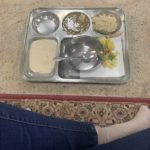Midday on a recent Sunday, The Sikh Cultural Society in Richmond Hill, Queens, is packed with the faithful. They come to pray, to socialize and to eat in a religious ceremony called langar—the communal meal shared after the prayers.
Everyone in the gurdwara is barefoot and wears a head covering. As worshipers enter the main service room, known as the Darbar Sahib, a man in a white linen gown scoops up a healthy portion of a sacred treat called parshad and places it in my bare, cupped hands. I rise and make my way to the opposite side of the room. Women on the left. Men on the right.
This separation, I am told, is done at some gurdwaras out of respect, to avoid distraction and to allow worshipers to feel comfortable, should their shirts rise when kneeling to pray or if they need to breastfeed a child. “It’s a completely cultural practice,” one worshiper, Tandeep Kaur, told me in a phone conversation. “It doesn’t have any religious background.”
After exiting the room of worship, I go down the stairs with other worshipers for the langar.
I grab a metal tray that comes complete with a metal bowl, metal spoon and napkin. This begins my experience with langar. The basement of the gurdwara serves as a community kitchen where volunteers cook the multiple meals and wash the hundreds of dishes. The Sikh house of worship and its kitchen are open continuously to anyone regardless of their faith.
I am directed by an elder volunteer to a spot on a burgundy runner rug.
Clink!
That is the sound the metal tray makes on the floor before me. My feet and legs then fold into the sukhasana position. In the Sikh faith, everyone sits on the floor, regardless of their identification, to show that all are equal. The practice has its origins in deconstructing the idea of the caste system.
 In the gigantic basement, a few single wooden benches and tables are around for those who can not physically descend to the ground. I sit in between a middle-aged man and woman who are unrelated. The wall in front of me is decorated with framed images of the gurus. My eyes track a little further where I spot a television broadcasting the prayers in the Darbar Sahib to those of us in the eating area.
In the gigantic basement, a few single wooden benches and tables are around for those who can not physically descend to the ground. I sit in between a middle-aged man and woman who are unrelated. The wall in front of me is decorated with framed images of the gurus. My eyes track a little further where I spot a television broadcasting the prayers in the Darbar Sahib to those of us in the eating area.
The lentil soup’s overpowering spices of cumin and cloves linger in my mouth. This is the dhal. Covering my plate is a sweet-tasting cheese and green pea curry called matar paneer, salad, peas pulao (lentil rice) and a dessert of rice pudding, called kheer. The pani, or water, sits in a metal bowl from the set awaiting consumption from the diners.
As we eat, the barefooted men make the rounds again with their vats of water, dhal, kheer, rice, parathas and salad asking those sitting if they would like additional servings.
After the meal, I get up and grab some hot chai (tea). I pace, unaware of where to stand or sit when a male volunteer gestures to me to have a seat at the end of yet another sliver of carpet. I thank him and seat myself at the far end of the reddish rug I have now grown accustomed to. I am in a row of men also sipping their chai and chatting or quietly contemplating. Around me are the voices of young children running around discussing their allowance, grades and what latest sneaker their good grades will allow their parents to buy for them.
In my stocking feet, I make my way up the stairs and through the long corridor before sharply turning right to retrieve my clothes. I get dressed and walk the pavements of Richmond Hill before stopping to visit the sign: Punjab Avenue.
